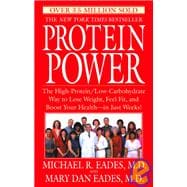
Note: Supplemental materials are not guaranteed with Rental or Used book purchases.
Purchase Benefits
What is included with this book?
| Acknowledgments | p. xi |
| Introduction | p. xiii |
| Assessing Your Risk | |
| A New Nutritional Perspective | p. 3 |
| The Symptom Treatment Trap | p. 19 |
| Excess Insulin and the Insulin Resistance Syndrome | p. 30 |
| Assessing Your Risk | p. 51 |
| The Protein Power Plan | |
| Putting It All Together: Designing Your Food Plan | p. 89 |
| Vitamins, Minerals, and Potassium | p. 169 |
| The Antiaging Formula: Exercise | p. 187 |
| Motivation: Plan Your Work and Work Your Plan | p. 207 |
| Sample Menus | p. 216 |
| Recipes | p. 225 |
| Why This Plan Will Leave You Healthy And Thin | |
| The Deadly Diseases of Civilization | p. 297 |
| The Microhormone Messengers: Meet the Eicosanoids | p. 331 |
| Cholesterol Madness | p. 360 |
| Epilogue: Overcoming the Curse of the Mummies | p. 394 |
| Sources and Resources | p. 409 |
| Index | p. 414 |
| Table of Contents provided by Syndetics. All Rights Reserved. |
The New copy of this book will include any supplemental materials advertised. Please check the title of the book to determine if it should include any access cards, study guides, lab manuals, CDs, etc.
The Used, Rental and eBook copies of this book are not guaranteed to include any supplemental materials. Typically, only the book itself is included. This is true even if the title states it includes any access cards, study guides, lab manuals, CDs, etc.
Excerpted from Protein Power by Michael R. Eades, Mary Dan Eades
All rights reserved by the original copyright owners. Excerpts are provided for display purposes only and may not be reproduced, reprinted or distributed without the written permission of the publisher.